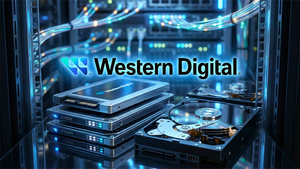
October 13, 2025 – Solaris Energy Infrastructure (NYSE: SEI) experienced a significant pre-market gap-up today, with its shares opening sharply higher at $48.70 after closing at $44.98, and subsequently trading at $49.55, marking an impressive 11.1% gain. This latest surge is not an isolated incident but rather a continuation of robust upward momentum that has seen the company's stock climb by 175% over the past year. The remarkable performance of Solaris Energy Infrastructure signals strong investor confidence in the company's strategic direction and underscores a broader, accelerating shift in investment toward resilient and adaptable energy infrastructure solutions.
The immediate implications of this sustained ascent are profound, suggesting a re-evaluation of valuation metrics within the energy infrastructure sector. Investors are increasingly recognizing the critical role that companies like Solaris play in supporting the burgeoning demands of modern digital economies, from AI and cloud computing to data centers. This upward trajectory for Solaris could serve as a powerful indicator for the investment landscape, potentially drawing further capital into companies poised to capitalize on the evolving energy grid and distributed power generation.
Unpacking Solaris's Meteoric Rise: A Confluence of Strategic Moves and Market Demand
Solaris Energy Infrastructure's impressive stock performance, culminating in today's gap-up, is the result of a meticulously executed strategy and a fortuitous alignment with burgeoning market needs. The company's journey to its current valuation has been punctuated by several key events over the past year.
The most immediate catalyst for the recent surges, including the current gap-up, stems from strategic financial maneuvers undertaken in early October 2025. Solaris successfully completed US$79.2 million in follow-on equity financing and upsized a convertible note issuance to US$650 million from an initial $600 million. These substantial funds are earmarked for critical objectives: repaying approximately $354 million in outstanding debt, investing $92 million into new 80 MW turbine capacity, and procuring additional power generation equipment. This shrewd capital management and investment in sustainable growth projects have been perceived by the market as major drivers of future profitability and operational expansion. Furthermore, the flexibility afforded by an amendment to its revolving credit facility to issue convertible debt has significantly de-risked these capital-intensive expansion plans.
Adding to the positive sentiment, unexpected insider stock purchases in early October and September 2025 significantly bolstered investor confidence, contributing to a substantial stock surge of over 17%. This insider activity signaled a strong belief in the company's intrinsic value and future prospects. The market also reacted positively to increased demand for Solaris's scalable equipment-based solutions for distributed power generation and logistics services, particularly within the oil and gas industry. The accelerating growth of artificial intelligence, cloud computing, and data centers has created an insatiable demand for reliable, uninterrupted power, a niche Solaris (NYSE: SEI) is expertly filling with its advanced power solutions.
Looking back, a pivotal moment in Solaris's growth trajectory was the September 2024 acquisition of Mobile Energy Rentals (MER), a distributed power business. This strategic move significantly expanded Solaris's service offerings and growth potential, contributing to a stock surge in January 2025 and laying the groundwork for its subsequent strong performance. The company's proactive engagement with the positive renewable energy outlook and broader sector trends, including upticks in the NYSE Energy Sector Index and the Energy Select Sector SPDR Fund, has further cemented its position as a market leader. With strong quarterly earnings projected—an estimated $0.24 earnings per share, representing a 200% year-over-year change, and revenues of $142.75 million, up 90.3%—investors are clearly betting on a continued growth story.
Ripple Effects: Winners and Losers in the Energy Infrastructure Landscape
The sustained bullish momentum surrounding Solaris Energy Infrastructure (NYSE: SEI) is poised to create distinct winners and losers across the broader energy infrastructure sector. Companies that share Solaris's strategic focus on distributed power generation, renewable energy integration, and robust solutions for data-intensive industries are likely to be the primary beneficiaries. Conversely, traditional energy providers slow to adapt to these evolving demands or those heavily reliant on outdated infrastructure may face increasing pressure.
Potential Winners: Companies specializing in modular power solutions, battery storage technologies, and advanced grid management systems stand to gain significantly. For instance, manufacturers of modular gas turbines or hybrid power systems, similar to what Solaris is investing in, could see increased demand for their products. Companies like Capstone Green Energy (NASDAQ: CGRN), which offers microturbine-based energy solutions, or Bloom Energy (NYSE: BE), focused on solid oxide fuel cell technology for distributed power, might experience a positive halo effect as investors seek out other players in this high-growth niche. Furthermore, firms providing critical components or services for the construction and maintenance of advanced energy infrastructure, especially those catering to data centers and industrial applications, could see an uptick in business. This includes engineering and construction firms with expertise in renewable energy projects and digital grid solutions.
Potential Losers: On the other hand, traditional utility companies with heavy investments in centralized, fossil-fuel-dependent power generation and limited exposure to distributed or renewable energy solutions may find themselves at a disadvantage. Their slower adaptation to the decentralization trend and the increasing demand for reliable, localized power could lead to lower investor confidence and potentially stagnant growth. Companies that primarily focus on legacy oil and gas logistics services without diversified energy offerings might also face headwinds as the market shifts towards more sustainable and efficient power solutions. While Solaris itself serves the oil and gas industry with logistics, its strategic diversification into advanced power generation for new digital demands positions it differently from pure-play legacy service providers. The capital expenditure required to pivot towards modern energy infrastructure is significant, and companies unable or unwilling to make these investments risk being left behind.
Ultimately, Solaris's success highlights a clear investment thesis: agility, innovation, and a focus on future-proof energy solutions are paramount. Companies that can demonstrate similar strategic foresight and execution in meeting the demands of a rapidly digitizing and decarbonizing world are likely to attract significant investor attention, while those clinging to conventional models may struggle to compete.
Wider Significance: A Paradigm Shift in Energy Investment
Solaris Energy Infrastructure's impressive performance is more than just a company-specific success story; it is a potent symbol of a paradigm shift occurring within the broader energy sector. This event fits squarely into several overarching industry trends, signaling a pivotal moment for how capital is allocated and value is perceived in energy infrastructure.
Firstly, the surge underscores the accelerating trend of decentralization in power generation. As demand for reliable, uninterrupted power grows—fueled by the exponential expansion of AI, cloud computing, and data centers—the traditional model of large, centralized power plants is being supplemented, and in some cases, challenged, by distributed energy resources (DERs). Solaris's investment in new turbine capacity and scalable equipment-based solutions directly addresses this need, providing localized, resilient power. This trend is not just about efficiency but also about enhancing grid stability and reducing transmission losses, making it a critical area for future investment.
Secondly, the event highlights the growing intersection of technology and energy. The demand drivers for Solaris's solutions are fundamentally technological, emphasizing that energy infrastructure is no longer a standalone sector but an integral component of the digital economy. This integration means that companies capable of providing advanced, flexible, and responsive power solutions are uniquely positioned for growth. The ripple effects extend to technology companies (e.g., NVIDIA (NASDAQ: NVDA), Microsoft (NASDAQ: MSFT)) that rely on massive data centers, as they will increasingly seek partnerships with energy providers that can guarantee their power needs. Conversely, energy companies that embrace digital transformation and smart grid technologies will gain a competitive edge.
Thirdly, there are significant regulatory and policy implications. As companies like Solaris demonstrate the viability and economic benefits of advanced energy infrastructure, policymakers may be incentivized to create more supportive regulatory frameworks. This could include streamlined permitting for DERs, incentives for grid modernization, and policies that encourage investment in energy storage and smart grid technologies. The focus on sustainable energy growth and the ability to flexibly issue convertible debt also points to a supportive financial environment for green and transitional energy projects, potentially influencing future government grants and financing programs.
Historically, periods of rapid technological advancement have always reshaped infrastructure. The railway boom, the electrification of cities, and the internet's expansion all necessitated massive infrastructure investments and created new market leaders. Solaris's current trajectory can be compared to these historical precedents, where companies that accurately identified and capitalized on emerging infrastructure needs achieved exponential growth. The current demand for digital infrastructure, coupled with the imperative for energy transition, creates a similar fertile ground for innovation and investment. This is not merely an energy play but an infrastructure play for the digital age.
What Comes Next: Navigating the Future of Energy Infrastructure Investment
The impressive trajectory of Solaris Energy Infrastructure (NYSE: SEI) points to a dynamic future for the energy infrastructure sector, presenting both exciting opportunities and significant challenges. Understanding what comes next requires an analysis of potential short-term and long-term developments, strategic adaptations, and emerging market landscapes.
In the short term, Solaris is poised for continued growth, fueled by its strong financial position, ongoing capacity expansion, and high demand for its specialized power solutions. The anticipated strong quarterly earnings report on November 3, 2025, will be a critical near-term catalyst. Positive results could further solidify investor confidence and potentially drive the stock higher, while any deviation might introduce short-term volatility. Investors will also closely monitor the execution of its US$650 million convertible note issuance and the deployment of funds for new turbine capacity. Successful integration and operationalization of these investments will be key to maintaining momentum.
Looking to the long term, Solaris and its peers will need to navigate an increasingly complex energy landscape. The sustained demand for distributed power, particularly from the data center and AI sectors, will necessitate continuous innovation in energy storage, grid intelligence, and renewable energy integration. Companies that can offer comprehensive, integrated solutions—combining generation, storage, and smart management—will likely emerge as market leaders. Solaris's strategic pivots will likely include further acquisitions of complementary businesses, deeper penetration into international markets, and potentially new technological ventures in areas like hydrogen fuel cells or advanced modular reactors, should these become economically viable. The high P/E ratio of 75.6x suggests that investors have significant growth expectations for the company, meaning Solaris must consistently deliver on its strategic promises to justify its valuation.
Market opportunities will emerge for companies that can address the intermittency of renewable energy sources through advanced battery storage solutions and smart grid technologies. The increasing decentralization of the grid will also create opportunities for companies offering microgrid solutions and energy management platforms. Conversely, challenges will include managing supply chain disruptions for critical components, navigating evolving regulatory landscapes, and mitigating the financial risks associated with large-scale infrastructure projects. Competition will also intensify as more players recognize the lucrative nature of this evolving sector.
Potential scenarios and outcomes range from Solaris becoming a dominant global player in distributed energy infrastructure, setting industry standards for reliability and innovation, to facing increased competition from tech giants entering the energy space or established utilities undergoing rapid transformation. Investors should watch for Solaris's ability to maintain its competitive edge through continuous R&D, strategic partnerships, and efficient capital deployment. The company's high daily volatility also means that while the upside can be significant, potential pullbacks should be anticipated and managed.
Wrap-Up: A New Horizon for Energy Infrastructure Investment
Solaris Energy Infrastructure's (NYSE: SEI) recent stock surge and sustained upward trend serve as a compelling narrative for the future of energy investment. The key takeaways from this event are clear: the energy infrastructure sector is undergoing a profound transformation, driven by the escalating demands of the digital economy, the imperative for decarbonization, and the strategic shift towards distributed and resilient power solutions. Solaris's success is a testament to the power of strategic acquisitions, astute financial management, and a keen understanding of evolving market needs.
Moving forward, the market will increasingly reward companies that demonstrate agility, innovation, and a commitment to building future-proof energy systems. Investors should recognize that the traditional energy sector is being redefined, with new growth vectors emerging from the intersection of energy, technology, and environmental sustainability. The ability of companies to provide reliable, scalable, and adaptable power solutions for critical infrastructure, such as data centers and AI operations, will be a primary determinant of their long-term value.
For investors, the significance of Solaris's performance extends beyond its individual stock. It provides a blueprint for identifying promising opportunities within the broader energy infrastructure landscape. While Solaris's high valuation and volatility warrant careful consideration, its trajectory highlights the potential for substantial returns in companies aligned with these megatrends. Investors should closely monitor companies investing in distributed generation, energy storage, smart grid technologies, and those with a strong focus on serving the power needs of the digital economy. The upcoming earnings report for Solaris on November 3, 2025, will be a crucial indicator, as will any further strategic announcements regarding expansion or technological advancements. The energy market is not just evolving; it is experiencing a renaissance, and companies like Solaris are at its forefront.
This content is intended for informational purposes only and is not financial advice





